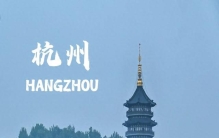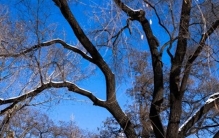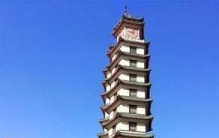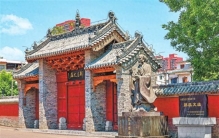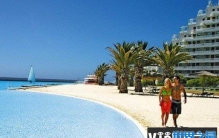中华豪门—古建构件—无雀替不成中华建筑
本期编辑/开鸿顺
KaiHongShun Studio
————————
雀替,是在中国古代建筑中,梁、枋与柱子之间的一个三角形的构件,就是那个跟翅膀一样的东西,其上多雕刻花鸟、龙凤、祥云等。
Queti is a triangular component between beams, architraves and columns in ancient Chinese architecture. It is the same thing as wings. It is mostly carved with flowers and birds, dragons and phoenixes, and auspicious clouds.
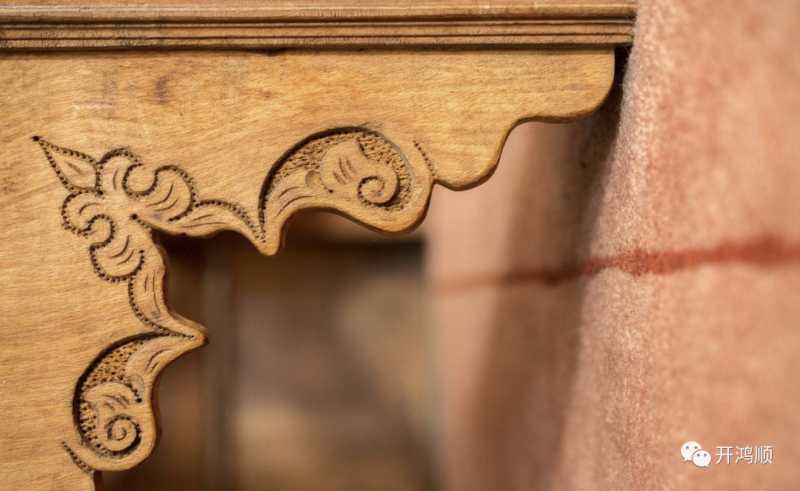
它的存在本来是为了减少梁、枋与柱相接处的向下剪力,防止横竖构材间的角度之倾斜——三角形的稳定性嘛,发展到后期却变化出了多种花样,早已超过了力学上的意义,而成了中国古建的重要组成部分,大有无雀替不成中华建筑之感。
Its existence was originally to reduce the downward shear force at the junction of beams, braces and columns, and prevent the inclination of the angles between the horizontal and vertical members - the stability of the triangle, but in the later stage, it has changed into a variety of patterns.
尤其是清代,雀替的结构和花样都到了登峰造极的地步,形成了七大样式,分别是:雀替、大雀替、小雀替、通雀替、骑马雀替、花牙子和龙门雀替。
Especially in the Qing Dynasty, the structure and pattern of Queti reached the peak, and formed seven patterns, namely, Queti, Grand Queti, Little Queti, Tongque, Riding Queti, Huayazi and Longmen Queti.
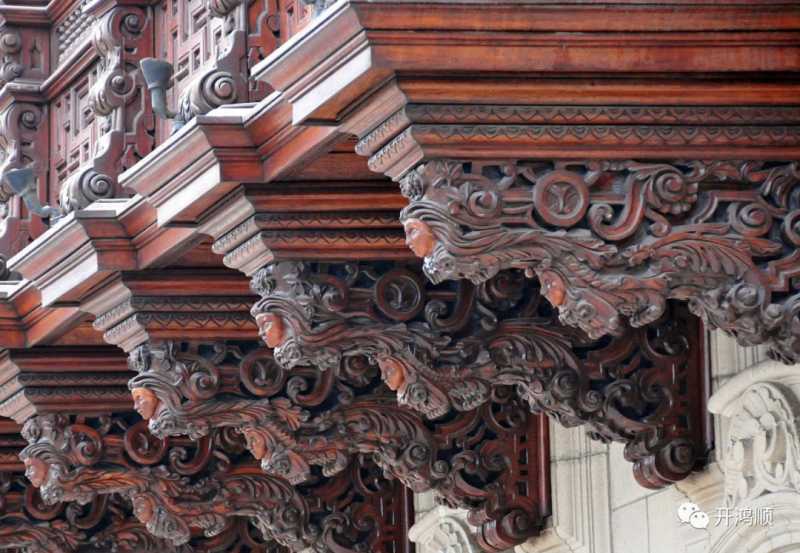
第一:雀替,这个也是我们平时在故宫建筑中最常见到的,在梁、枋与柱子之间,用暗销插入柱内。清代规定,官样建筑中雀替的长度占开间(柱子和柱子之间)宽度的四分之一。
First: Queti, which is also the most common thing we usually see in the Forbidden City buildings, is inserted into the columns with dowels between beams, braces and columns. According to the regulations of the Qing Dynasty, the length of the sparrow in the official buildings accounts for a quarter of the width of the bay (between the columns).
第二:大雀替,它是将两个雀替连成一块,整木雕成,如此长度也翻倍,所以称之为大雀替。而且一般的雀替是从侧面插入柱内,它则是直接安在柱子的上头,承托起梁、枋的重量,跟一般雀替相比,它在力学上的作用更加突出。大雀替主要出现在西藏、青海等地区的喇嘛庙,其他古建中很罕见。
The second is the Great Bird's Nest. It is made of two bird's nests and carved into a piece of wood. The length is doubled, so it is called the Great Bird's Nest. Moreover, the general Queti is inserted into the column from the side, and it is directly installed on the top of the column to support the weight of beams and braces.
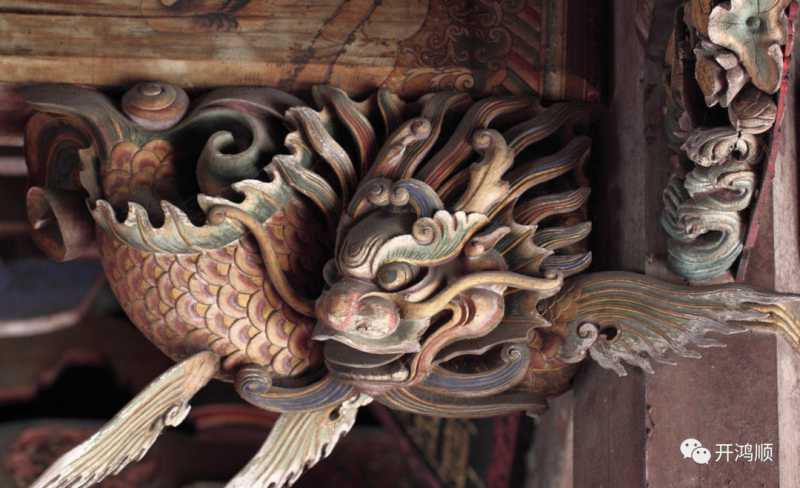
第三:小雀替。相对于北方抬梁式建筑的粗梁大柱而言,江南建筑较多采用穿斗式结构,扁梁细柱,而且梁柱数量又多,所以单个梁柱之间向下的剪力比较小,这时候雀替的存在在力学上的作用较小,更多是装饰作用,通常做得纤细小巧,厚度也比较薄,所以叫做小雀替。
Third: Little Bird. Compared with the thick beams and columns of the northern beam-lifting buildings, the buildings in the south of the Yangtze River mostly adopt the bucket structure, the flat beams and thin columns, and the number of beams and columns is large, so the downward shear force between the single beams and columns is relatively small.
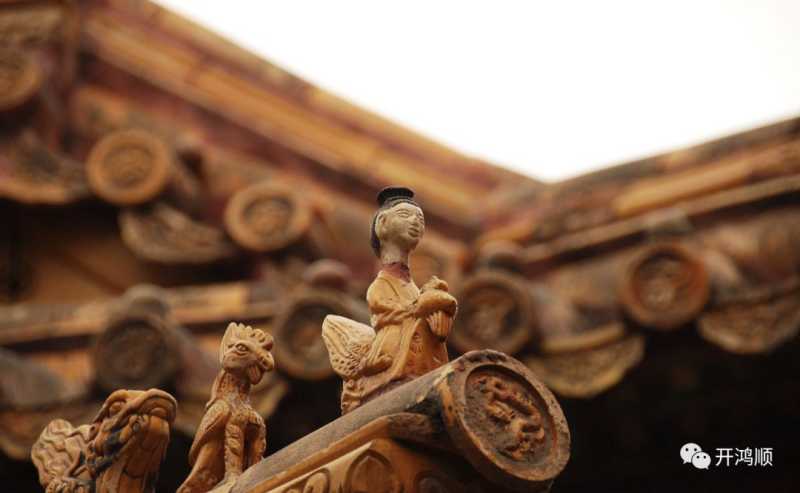
第四:通雀替。这个跟大雀替类似,由整木雕成,两雀替连在一块。区别是:大雀替是直接安在柱子的上头,而通雀替却是夹在柱子之间,由于它安装时打通了柱子,所以叫通雀替。通雀替一般用在室内,这也是它区别于其他雀替的一个标志。
Fourth: Tong Queti. This is similar to the Great Bird's Nest. It is carved from the whole wood. The two bird's nests are connected together. The difference is that the Great Bird's Nest is directly installed on the top of the column, while the Great Bird's Nest is sandwiched between the columns.
第五:骑马雀替。有时柱子和柱子相隔太近,两根柱子中间的宽度无法容纳下两个雀替,只能尖与尖对连在一起变成一个雀替,从而形成了一种马鞍的形状,这种马鞍形的雀替就叫做骑马雀替。
Fifth: riding a horse for a bird. Sometimes the columns are too close to each other, and the width between the two columns cannot accommodate the next two finches. The only way is to connect the tip with the tip to form a finch, thus forming a saddle shape. This saddle-shaped finch is called riding finch.
第六:花牙子。镂空雕刻或者用细棂条拼接在一起的雀替,比较脆弱,完全没有力学上的作用,只是用来装饰,就像它的名字一样,只是做个花样。
Sixth: Hua Yazi. The sparrow, which is carved out or spliced together with thin mullions, is relatively fragile and has no mechanical function at all. It is only used for decoration, just like its name, just to make a pattern.
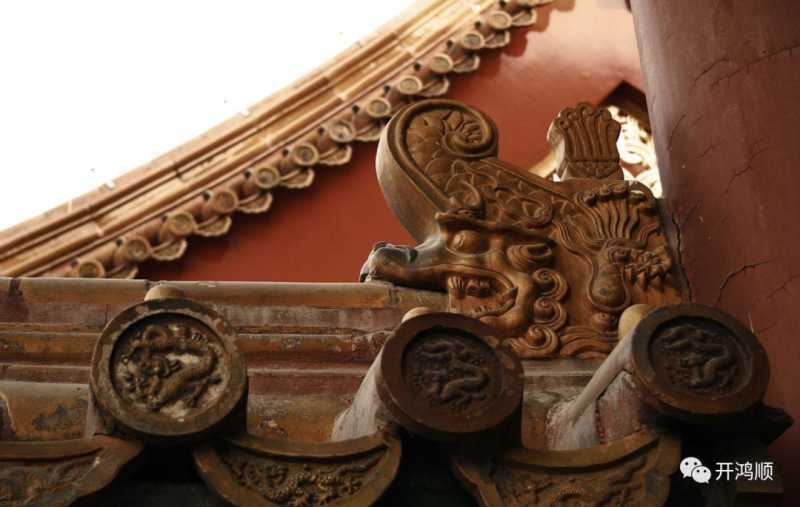
柱与柱之间距离过短时,会把两个花牙子做成一块,这时它跟骑马雀替很像,也是马鞍形的,二者区别不是太明显,主要是看镂空的程度,花牙子镂空程度更夸张;
If the distance between columns is too short, the two flower teeth will be made into a piece. At this time, it is very similar to the horseback sparrow, and it is also saddle-shaped. The difference between the two is not too obvious. The main reason is that the hollowing degree of flower teeth is more exaggerated;
柱与柱之间距离太长时,做花牙子的话,会将整木镂空雕成、或者细棂条拼成多个雀替连在一起的样子,悬挂在檐额下,这种花牙子又称“挂落”。
When the distance between columns is too long, the whole wood will be hollowed out and carved, or the thin mullions will be assembled into several sparrows and hung under the eaves, which is also called "hanging down".
第七:龙门雀替,这个主要用在牌楼上,而且比一般的雀替多了很多小零件,比如云墩、梓框、三福云等。尤其是从外到内插在其上的三福云,是龙门雀替最醒目的一个标志。
Seventh: Longmen Queti, which is mainly used on archways, has many more small parts than ordinary Queti, such as Yundun, Zibo, Sanfuyun, etc. In particular, the Sanfu Cloud, which is inserted on it from outside to inside, is the most striking symbol of Longmen Queti.
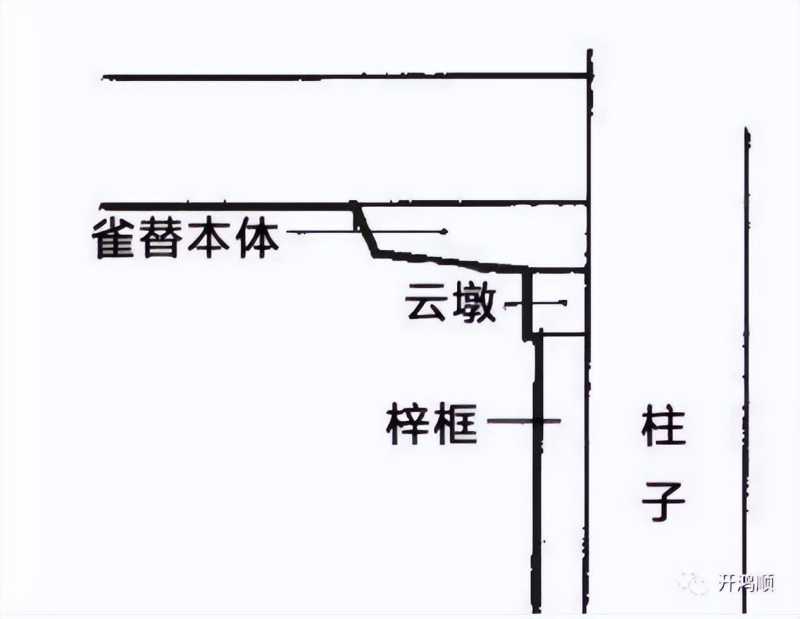
龙门雀替图解
雀替的结构样式就是这七种了,看完本文后,下次再欣赏中国古代建筑时,你应该就不会忽略梁柱之间这一个小小的构件了吧。
These are the seven structural styles of Queti. After reading this article, the next time you appreciate ancient Chinese architecture, you should not ignore this small component between beams and columns.
大家都在看
-
跃动杭州:建筑在千古江南和数字脉搏之间 钱塘潮涌,奔竞不息;西子湖畔,风骨依然。杭州,这一座兼具江南烟雨与时代锋芒的“弄潮儿”之城,它的美,不止于水墨丹青。西湖是它底蕴的静气,钱江潮是它奔涌的血脉。当中建三局一公司的建设者们,将足迹印刻在这 ... 建筑之最08-23
-
击败北京,这座小城拿下“世界建筑之都”NO.1!网友:爽死强迫症 说起城市建筑,巴塞罗那一直是封神般的存在。早在几年前,它以微弱优势击败北京,拿下了“2026年世界建筑之都”的称号。这座地中海畔的明珠,本身就是一部生动的建筑史书。从古罗马遗迹到中世纪哥特街区,再到19世纪 ... 建筑之最08-23
-
飞檐翘角间的华夏智慧:探寻中国古建筑屋顶曲线之美 当我们漫步于古老的街巷,或是参观宏伟的宫殿庙宇,目光总会被那造型独特、曲线优美的古建筑屋顶所吸引。中国古建筑屋顶,或轻盈灵动,或庄重典雅,其曲线设计宛如一幅流动的画卷,在岁月的长河中展现着独特的魅力。 ... 建筑之最08-23
-
郑州有哪些具有代表性的建筑? 郑州有许多具有代表性的建筑,以下是一些最能表示郑州的建筑:历史文化类- 二七纪念塔:位于郑州市二七广场,建于1971年,是为纪念京汉铁路工人大罢工而修建的纪念性建筑物,也是郑州市的重要标志,国内外游客的必游 ... 建筑之最08-23
-
了不起的古建筑丨郏县文庙:小城有大成 郏县文庙大门。大成殿上的木雕、石刻,造型精美、栩栩如生。俯瞰郏县文庙。大成殿的月台前,有一块雕刻着“二龙戏蜘蛛”的龙陛石。位于文庙东轴线南部的魁星楼。□本报记者 张体义/文 邓放/图文庙点亮暑期游。每年暑 ... 建筑之最08-23
-
世界上最大的游泳池,面积足足有80000平方米,花费了350万美金! 阿尔加罗沃泳池坐落智利,是世界上最大的游水池。它能有多大,才干在世界上排名第一呢?你可不能小看了这个游水池,它的面积足足有80000平方米,这等所以6000个标准游水池巨细的总和。为了建造这么大的一个游水池, ... 建筑之最08-19
-
中国最大的建筑是什么(成都新世纪环球中心) 中国成都新世纪环球中心 是全球房屋面积最大的建筑体,这里有许多办公室、会议室、一个大型购物中心、两个可以容纳千人的宾馆、一个溜冰场、一个IMAX电影院,甚至还有一个人造海景村,配备人造海滩和世界上最大的人 ... 建筑之最08-19
-
世界十大最贵建筑工程,美国洲际工程耗资4590亿美元 今天我们来说说世界上最贵的建筑工程,要单单说建筑,那不会达到几千亿美元,但在建筑后面加上一个工程,那这个数字就可以无限放大,可以达到空间站,以及州际公路这些庞大的建筑工程,那么世界上有哪些耗资巨大的建 ... 建筑之最08-19
-
未来全球最大机场,耗资上亿美元! 大家对于未来十大机场也是非常有争议的,美国现在是可以说航空领域最发达的国家之一,而且全球最大排名前3的机场都在美国,所以说,美国对于飞机航空这一方面的发展是非常强大的,而接下来小编带大家了解一下最有争 ... 建筑之最08-19
-
世界十个建筑之“最” 1、最大的单体行政建筑——美国五角大楼。总建筑面积达650万平方英尺(合60.4万平方米),其中办公面积为370万平方英尺(合34.4万平方米)。五角大楼共有五个外立面,建筑分为五层。2、最大的独立建筑工程——三峡水 ... 建筑之最07-02
相关文章
- 世界十个建筑之“最”
- 故宫、安徽宏村、福建土楼……谁是你心目中的中国建筑之最?
- 我国历史上的建筑工程之最
- 中国古建筑上最浪漫、最具想象力的设计之美,您一定见过
- 建筑美学赏析
- 上古不可思议的巨石建筑,到底是巨人杰作还是外星文明残存?
- 应县木塔又又又倾斜,看一眼少一眼的古建瑰宝
- 惊魂瞬间!341万修缮的明代鼓楼突现塌方 砖瓦如雨坠落惊呆路人
- 地球上这些超越时代的巨型建筑,是否暗示着史前超级文明的存在?
- 旅顺小龟山堡垒的三个之最
- 山东烟台1904年的老照片,110年前登州府繁荣景象
- 文化中国行丨从 “天圆地方” 到最速曲线 古人把哲学与科学“搬进”天坛
- 文化中国行丨天坛:与天地“对话”的传世古建
- 苏州十大高楼最新排名:苏州国际金融中心排第一,高450米
- 2023年浙江省高楼排名前十:杭州之门排榜首,高米310米
- 杭州十大高楼排行榜:杭州世纪中心夺冠,高度310米
- 重庆十大地标性建筑,解放碑位列榜首
- 杭州十大最高建筑排名,杭州世纪中心高310米排第一位
- 南京十大标志性建筑,南京总统府名列榜首
- 法国十大著名的建筑物,埃菲尔铁塔登顶第一名
热门阅读
-
全球十大摩天轮排行:天津之眼直径达110米 04-03
-
全球十大最高的桥梁,中国独占八座 04-14
-
2020年全球十大高楼排名,中国占了6座! 05-12
-
贵州十大名桥排行榜,北盘江大桥全长1341.4米 05-14
-
世界上最美的十大教堂,凡蒂冈圣彼得教堂位列第一 05-15
-
埃及十大著名神庙,卢克索神庙位居榜首 05-30
-
深圳十大高楼排行榜,平安金融中心高达592.5米 07-11

